Green Marketing Strategies: Consumer Behavior and Business Impact
VerifiedAdded on 2023/01/13
|28
|6538
|43
Report
AI Summary
This report delves into the realm of green marketing, examining its profound impact on consumer purchasing decisions and the strategies employed by businesses. It begins with an introduction to green marketing, outlining its aims and objectives, and establishes a research hypothesis to be tested. A comprehensive literature review explores the factors influencing organizations to adopt green marketing, the reasons driving consumers to purchase eco-friendly products, and the impact of green marketing on a global scale. The review also assesses the benefits and challenges associated with green marketing plans, offering valuable recommendations. The research methodology details the research philosophy, approach, data types, collection methods, and analysis techniques employed. The findings and analysis section presents and interprets secondary data, followed by a conclusion summarizing the key insights, acknowledging research limitations, and suggesting areas for future study. The report underscores the significance of green marketing in today's business landscape, highlighting its influence on both consumer behavior and corporate strategies.
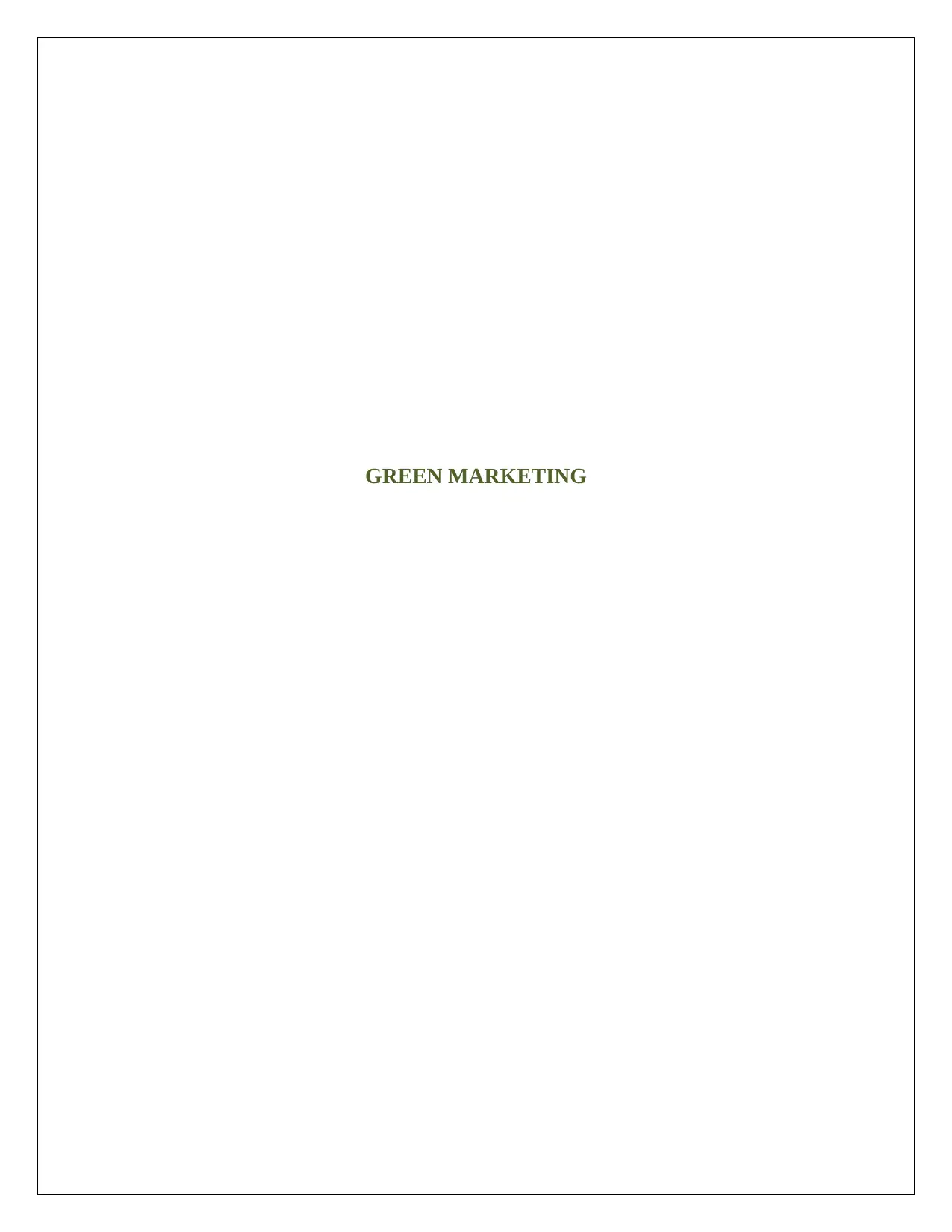
GREEN MARKETING
Paraphrase This Document
Need a fresh take? Get an instant paraphrase of this document with our AI Paraphraser
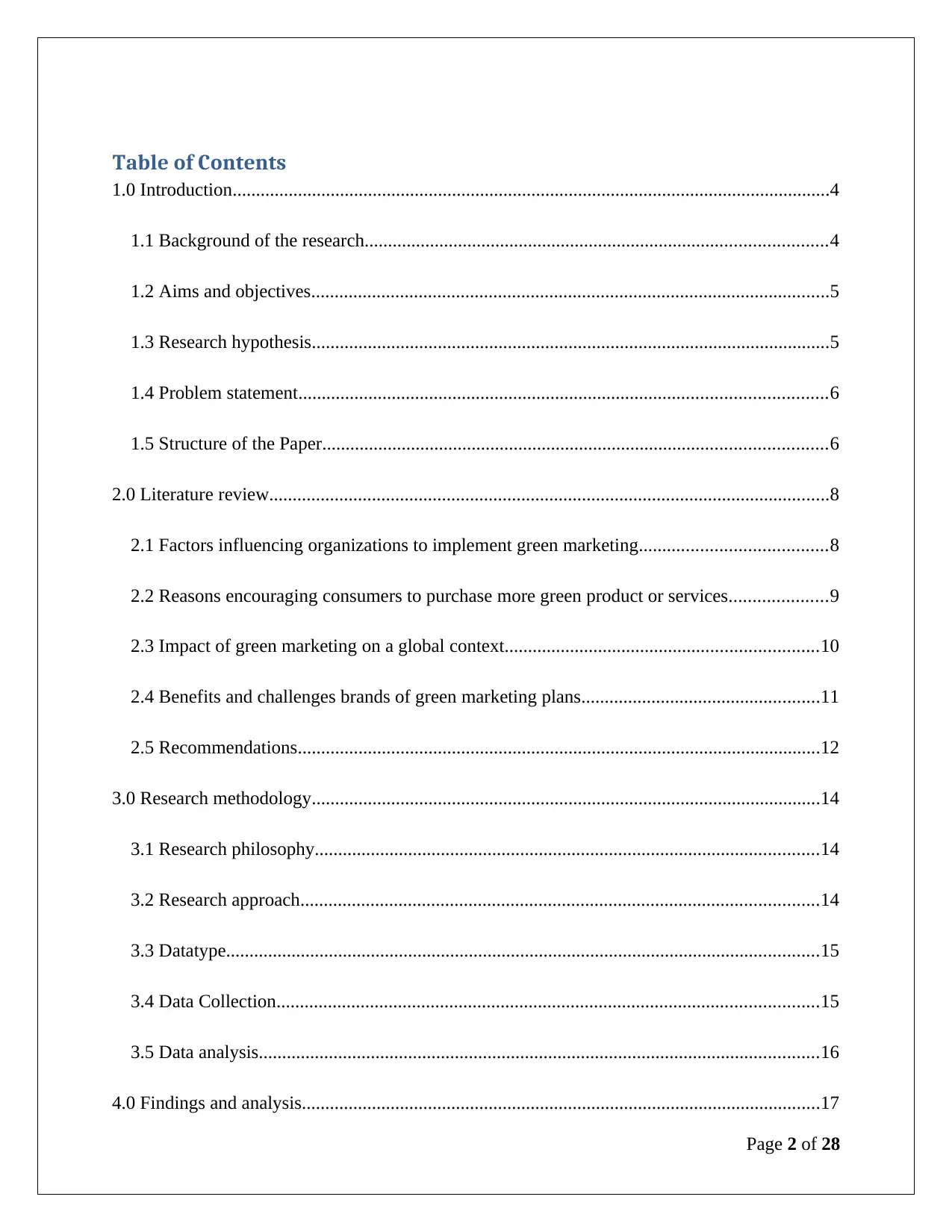
Table of Contents
1.0 Introduction................................................................................................................................4
1.1 Background of the research...................................................................................................4
1.2 Aims and objectives...............................................................................................................5
1.3 Research hypothesis...............................................................................................................5
1.4 Problem statement.................................................................................................................6
1.5 Structure of the Paper............................................................................................................6
2.0 Literature review........................................................................................................................8
2.1 Factors influencing organizations to implement green marketing........................................8
2.2 Reasons encouraging consumers to purchase more green product or services.....................9
2.3 Impact of green marketing on a global context...................................................................10
2.4 Benefits and challenges brands of green marketing plans...................................................11
2.5 Recommendations................................................................................................................12
3.0 Research methodology.............................................................................................................14
3.1 Research philosophy............................................................................................................14
3.2 Research approach...............................................................................................................14
3.3 Datatype...............................................................................................................................15
3.4 Data Collection....................................................................................................................15
3.5 Data analysis........................................................................................................................16
4.0 Findings and analysis...............................................................................................................17
Page 2 of 28
1.0 Introduction................................................................................................................................4
1.1 Background of the research...................................................................................................4
1.2 Aims and objectives...............................................................................................................5
1.3 Research hypothesis...............................................................................................................5
1.4 Problem statement.................................................................................................................6
1.5 Structure of the Paper............................................................................................................6
2.0 Literature review........................................................................................................................8
2.1 Factors influencing organizations to implement green marketing........................................8
2.2 Reasons encouraging consumers to purchase more green product or services.....................9
2.3 Impact of green marketing on a global context...................................................................10
2.4 Benefits and challenges brands of green marketing plans...................................................11
2.5 Recommendations................................................................................................................12
3.0 Research methodology.............................................................................................................14
3.1 Research philosophy............................................................................................................14
3.2 Research approach...............................................................................................................14
3.3 Datatype...............................................................................................................................15
3.4 Data Collection....................................................................................................................15
3.5 Data analysis........................................................................................................................16
4.0 Findings and analysis...............................................................................................................17
Page 2 of 28
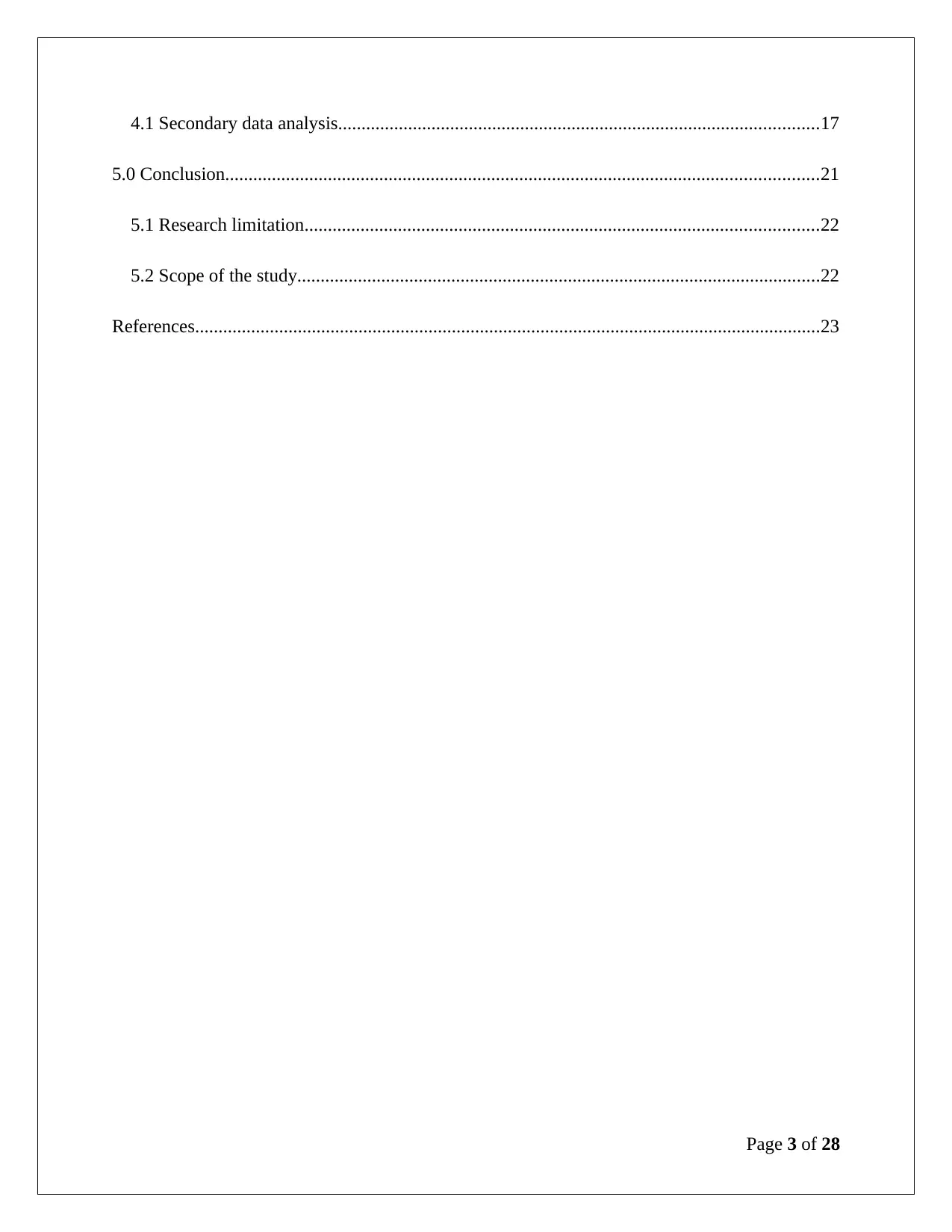
4.1 Secondary data analysis.......................................................................................................17
5.0 Conclusion...............................................................................................................................21
5.1 Research limitation..............................................................................................................22
5.2 Scope of the study................................................................................................................22
References......................................................................................................................................23
Page 3 of 28
5.0 Conclusion...............................................................................................................................21
5.1 Research limitation..............................................................................................................22
5.2 Scope of the study................................................................................................................22
References......................................................................................................................................23
Page 3 of 28
⊘ This is a preview!⊘
Do you want full access?
Subscribe today to unlock all pages.

Trusted by 1+ million students worldwide
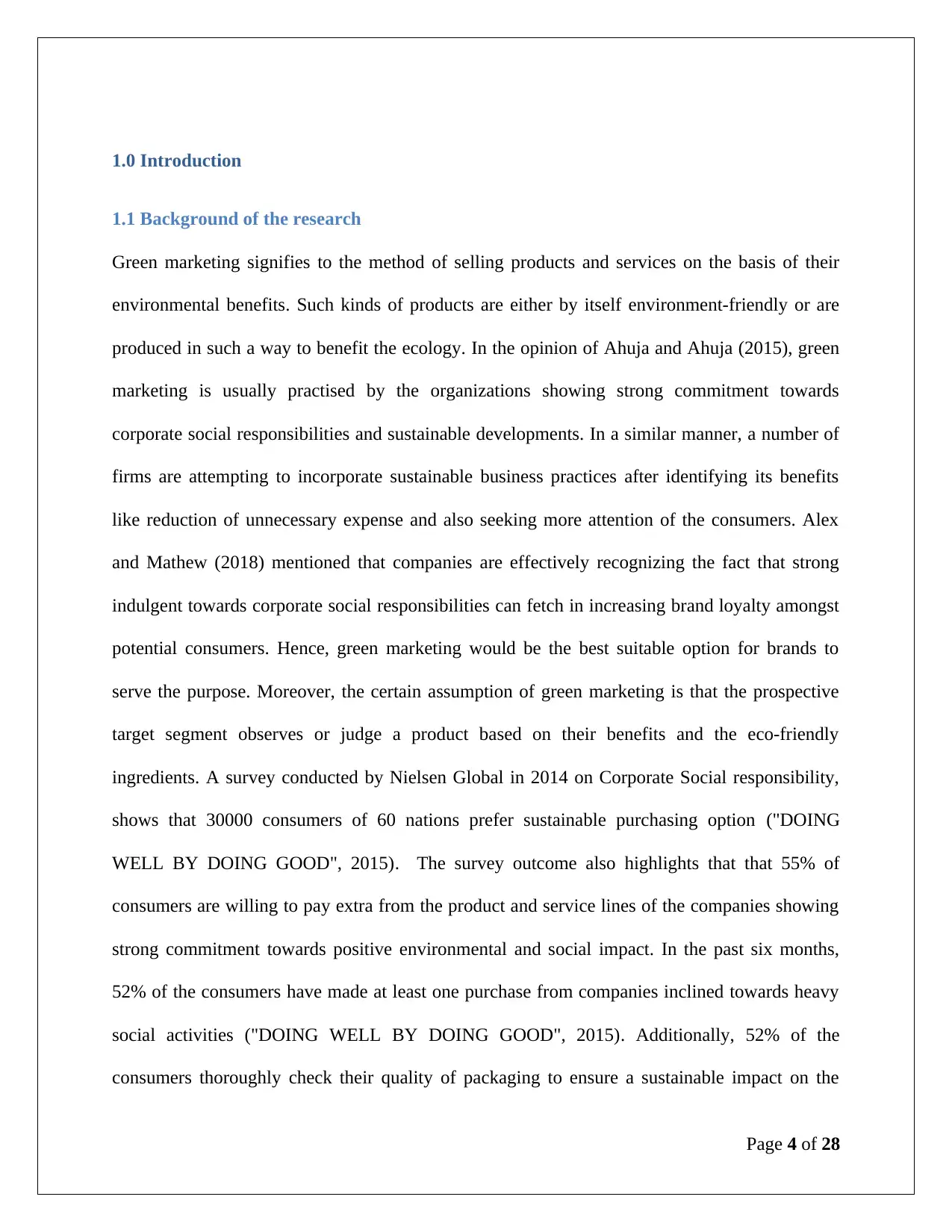
1.0 Introduction
1.1 Background of the research
Green marketing signifies to the method of selling products and services on the basis of their
environmental benefits. Such kinds of products are either by itself environment-friendly or are
produced in such a way to benefit the ecology. In the opinion of Ahuja and Ahuja (2015), green
marketing is usually practised by the organizations showing strong commitment towards
corporate social responsibilities and sustainable developments. In a similar manner, a number of
firms are attempting to incorporate sustainable business practices after identifying its benefits
like reduction of unnecessary expense and also seeking more attention of the consumers. Alex
and Mathew (2018) mentioned that companies are effectively recognizing the fact that strong
indulgent towards corporate social responsibilities can fetch in increasing brand loyalty amongst
potential consumers. Hence, green marketing would be the best suitable option for brands to
serve the purpose. Moreover, the certain assumption of green marketing is that the prospective
target segment observes or judge a product based on their benefits and the eco-friendly
ingredients. A survey conducted by Nielsen Global in 2014 on Corporate Social responsibility,
shows that 30000 consumers of 60 nations prefer sustainable purchasing option ("DOING
WELL BY DOING GOOD", 2015). The survey outcome also highlights that that 55% of
consumers are willing to pay extra from the product and service lines of the companies showing
strong commitment towards positive environmental and social impact. In the past six months,
52% of the consumers have made at least one purchase from companies inclined towards heavy
social activities ("DOING WELL BY DOING GOOD", 2015). Additionally, 52% of the
consumers thoroughly check their quality of packaging to ensure a sustainable impact on the
Page 4 of 28
1.1 Background of the research
Green marketing signifies to the method of selling products and services on the basis of their
environmental benefits. Such kinds of products are either by itself environment-friendly or are
produced in such a way to benefit the ecology. In the opinion of Ahuja and Ahuja (2015), green
marketing is usually practised by the organizations showing strong commitment towards
corporate social responsibilities and sustainable developments. In a similar manner, a number of
firms are attempting to incorporate sustainable business practices after identifying its benefits
like reduction of unnecessary expense and also seeking more attention of the consumers. Alex
and Mathew (2018) mentioned that companies are effectively recognizing the fact that strong
indulgent towards corporate social responsibilities can fetch in increasing brand loyalty amongst
potential consumers. Hence, green marketing would be the best suitable option for brands to
serve the purpose. Moreover, the certain assumption of green marketing is that the prospective
target segment observes or judge a product based on their benefits and the eco-friendly
ingredients. A survey conducted by Nielsen Global in 2014 on Corporate Social responsibility,
shows that 30000 consumers of 60 nations prefer sustainable purchasing option ("DOING
WELL BY DOING GOOD", 2015). The survey outcome also highlights that that 55% of
consumers are willing to pay extra from the product and service lines of the companies showing
strong commitment towards positive environmental and social impact. In the past six months,
52% of the consumers have made at least one purchase from companies inclined towards heavy
social activities ("DOING WELL BY DOING GOOD", 2015). Additionally, 52% of the
consumers thoroughly check their quality of packaging to ensure a sustainable impact on the
Page 4 of 28
Paraphrase This Document
Need a fresh take? Get an instant paraphrase of this document with our AI Paraphraser
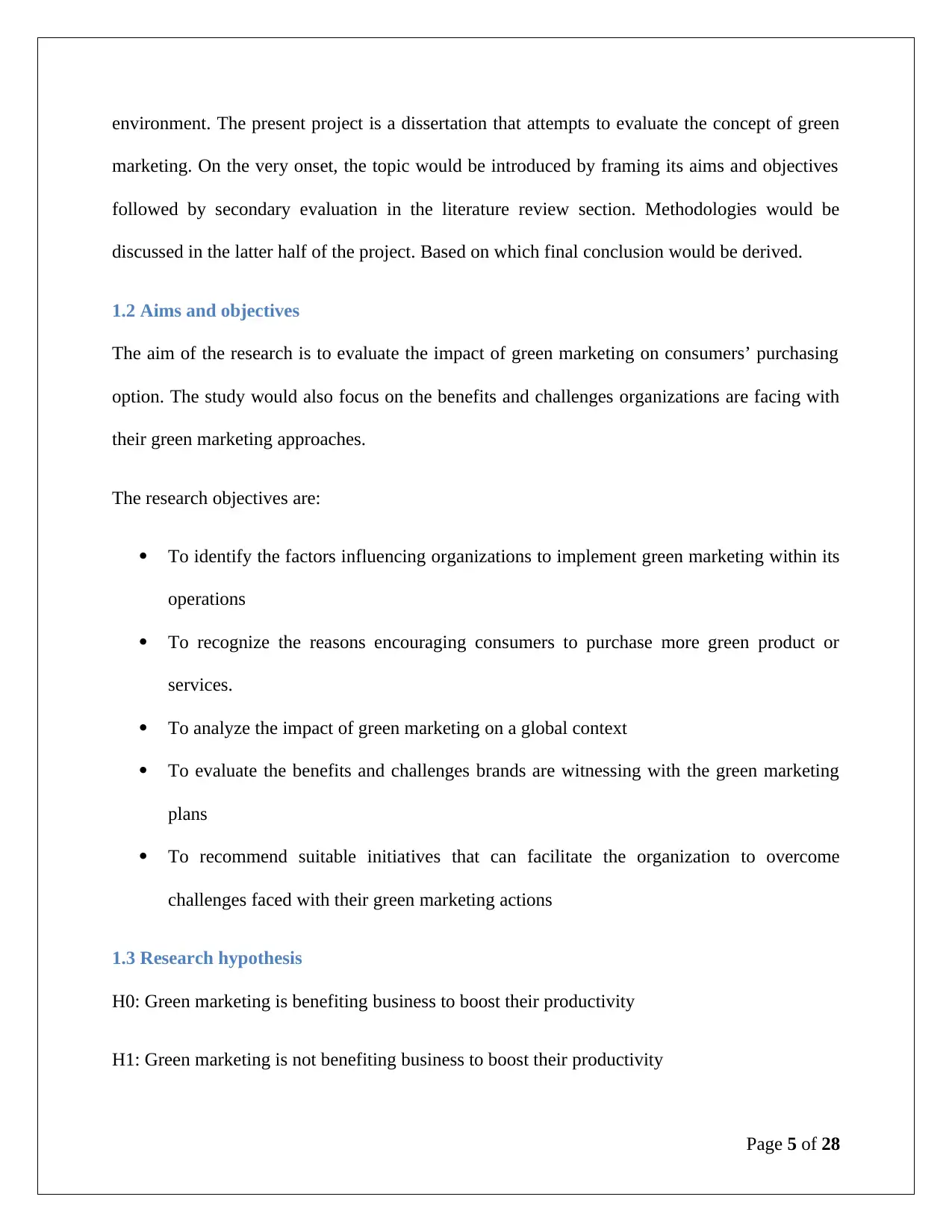
environment. The present project is a dissertation that attempts to evaluate the concept of green
marketing. On the very onset, the topic would be introduced by framing its aims and objectives
followed by secondary evaluation in the literature review section. Methodologies would be
discussed in the latter half of the project. Based on which final conclusion would be derived.
1.2 Aims and objectives
The aim of the research is to evaluate the impact of green marketing on consumers’ purchasing
option. The study would also focus on the benefits and challenges organizations are facing with
their green marketing approaches.
The research objectives are:
To identify the factors influencing organizations to implement green marketing within its
operations
To recognize the reasons encouraging consumers to purchase more green product or
services.
To analyze the impact of green marketing on a global context
To evaluate the benefits and challenges brands are witnessing with the green marketing
plans
To recommend suitable initiatives that can facilitate the organization to overcome
challenges faced with their green marketing actions
1.3 Research hypothesis
H0: Green marketing is benefiting business to boost their productivity
H1: Green marketing is not benefiting business to boost their productivity
Page 5 of 28
marketing. On the very onset, the topic would be introduced by framing its aims and objectives
followed by secondary evaluation in the literature review section. Methodologies would be
discussed in the latter half of the project. Based on which final conclusion would be derived.
1.2 Aims and objectives
The aim of the research is to evaluate the impact of green marketing on consumers’ purchasing
option. The study would also focus on the benefits and challenges organizations are facing with
their green marketing approaches.
The research objectives are:
To identify the factors influencing organizations to implement green marketing within its
operations
To recognize the reasons encouraging consumers to purchase more green product or
services.
To analyze the impact of green marketing on a global context
To evaluate the benefits and challenges brands are witnessing with the green marketing
plans
To recommend suitable initiatives that can facilitate the organization to overcome
challenges faced with their green marketing actions
1.3 Research hypothesis
H0: Green marketing is benefiting business to boost their productivity
H1: Green marketing is not benefiting business to boost their productivity
Page 5 of 28
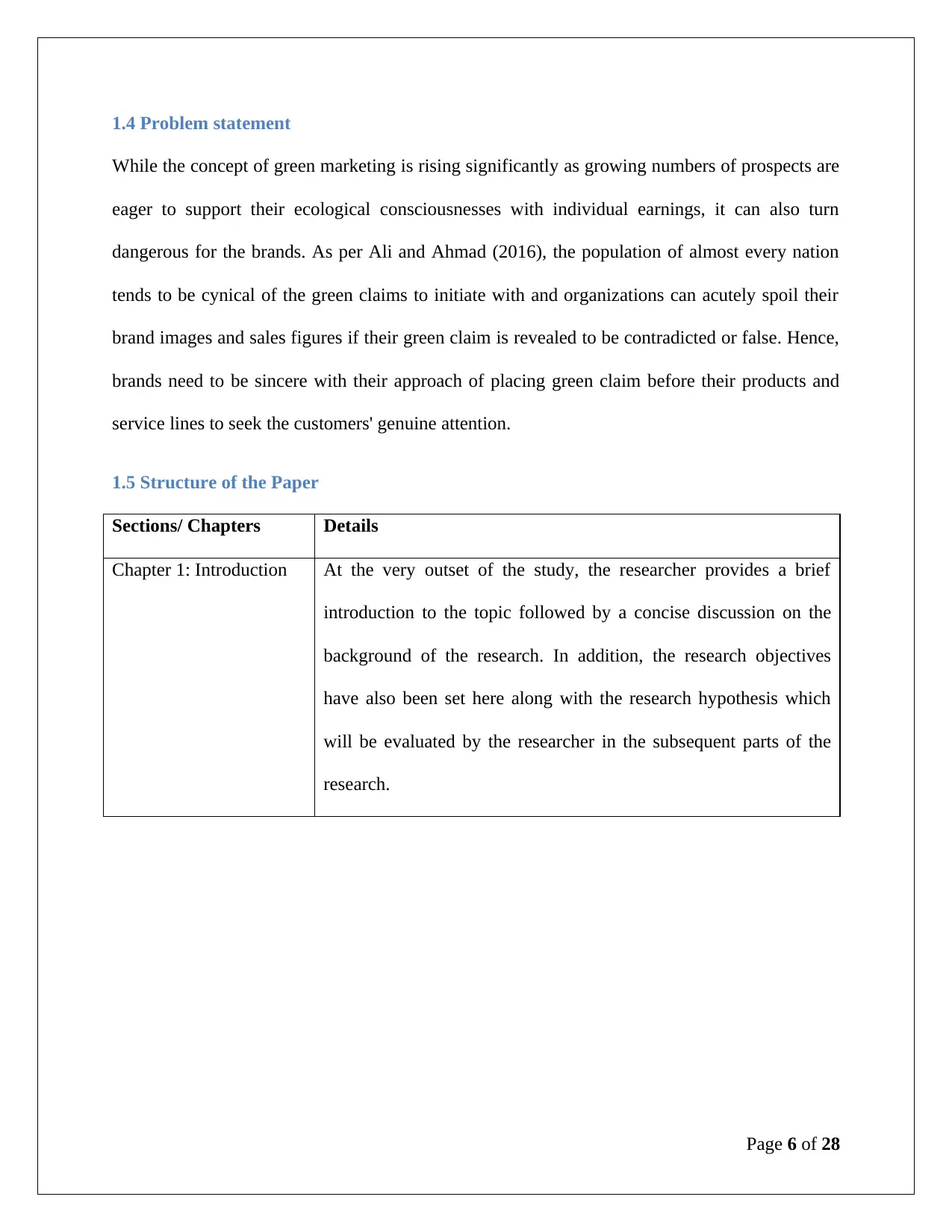
1.4 Problem statement
While the concept of green marketing is rising significantly as growing numbers of prospects are
eager to support their ecological consciousnesses with individual earnings, it can also turn
dangerous for the brands. As per Ali and Ahmad (2016), the population of almost every nation
tends to be cynical of the green claims to initiate with and organizations can acutely spoil their
brand images and sales figures if their green claim is revealed to be contradicted or false. Hence,
brands need to be sincere with their approach of placing green claim before their products and
service lines to seek the customers' genuine attention.
1.5 Structure of the Paper
Sections/ Chapters Details
Chapter 1: Introduction At the very outset of the study, the researcher provides a brief
introduction to the topic followed by a concise discussion on the
background of the research. In addition, the research objectives
have also been set here along with the research hypothesis which
will be evaluated by the researcher in the subsequent parts of the
research.
Page 6 of 28
While the concept of green marketing is rising significantly as growing numbers of prospects are
eager to support their ecological consciousnesses with individual earnings, it can also turn
dangerous for the brands. As per Ali and Ahmad (2016), the population of almost every nation
tends to be cynical of the green claims to initiate with and organizations can acutely spoil their
brand images and sales figures if their green claim is revealed to be contradicted or false. Hence,
brands need to be sincere with their approach of placing green claim before their products and
service lines to seek the customers' genuine attention.
1.5 Structure of the Paper
Sections/ Chapters Details
Chapter 1: Introduction At the very outset of the study, the researcher provides a brief
introduction to the topic followed by a concise discussion on the
background of the research. In addition, the research objectives
have also been set here along with the research hypothesis which
will be evaluated by the researcher in the subsequent parts of the
research.
Page 6 of 28
⊘ This is a preview!⊘
Do you want full access?
Subscribe today to unlock all pages.

Trusted by 1+ million students worldwide
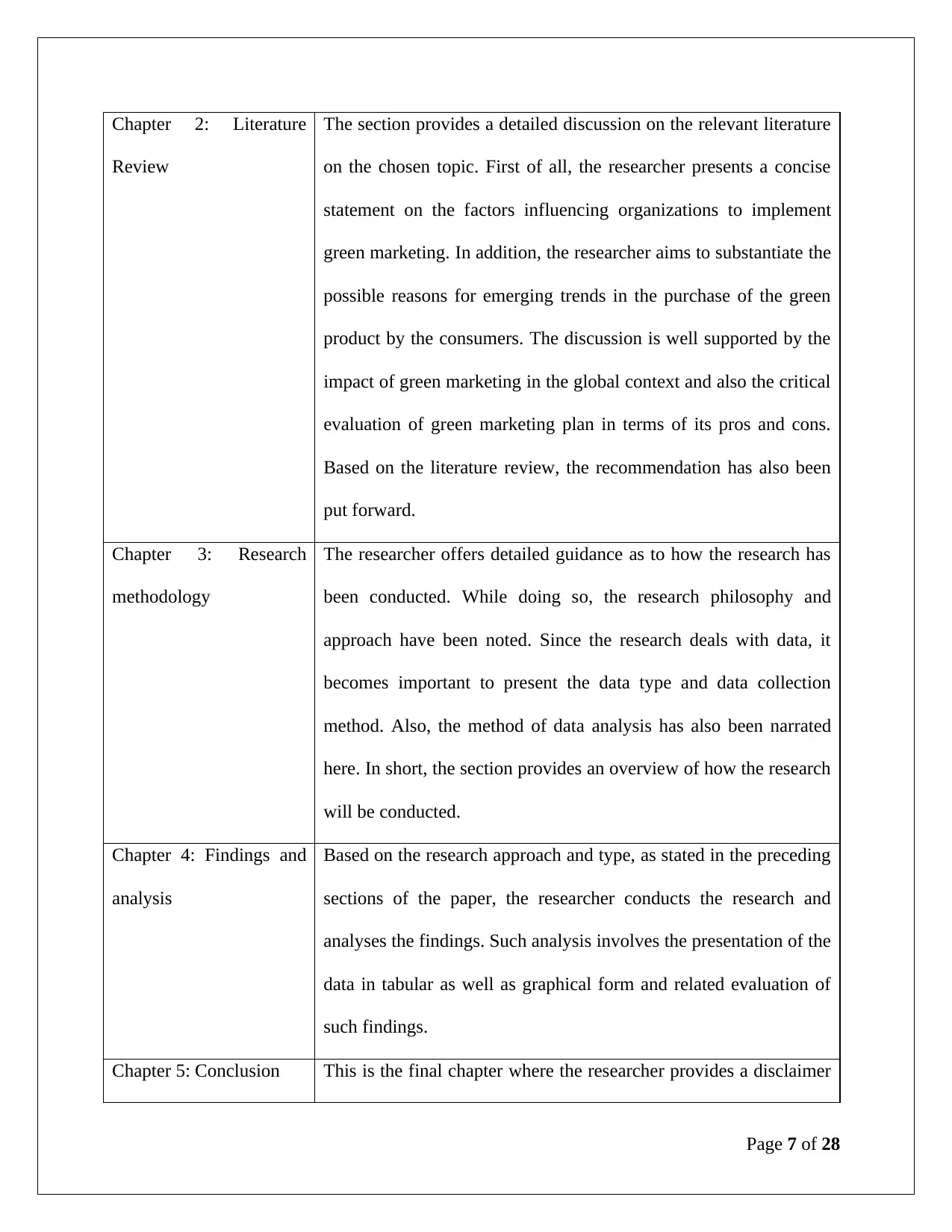
Chapter 2: Literature
Review
The section provides a detailed discussion on the relevant literature
on the chosen topic. First of all, the researcher presents a concise
statement on the factors influencing organizations to implement
green marketing. In addition, the researcher aims to substantiate the
possible reasons for emerging trends in the purchase of the green
product by the consumers. The discussion is well supported by the
impact of green marketing in the global context and also the critical
evaluation of green marketing plan in terms of its pros and cons.
Based on the literature review, the recommendation has also been
put forward.
Chapter 3: Research
methodology
The researcher offers detailed guidance as to how the research has
been conducted. While doing so, the research philosophy and
approach have been noted. Since the research deals with data, it
becomes important to present the data type and data collection
method. Also, the method of data analysis has also been narrated
here. In short, the section provides an overview of how the research
will be conducted.
Chapter 4: Findings and
analysis
Based on the research approach and type, as stated in the preceding
sections of the paper, the researcher conducts the research and
analyses the findings. Such analysis involves the presentation of the
data in tabular as well as graphical form and related evaluation of
such findings.
Chapter 5: Conclusion This is the final chapter where the researcher provides a disclaimer
Page 7 of 28
Review
The section provides a detailed discussion on the relevant literature
on the chosen topic. First of all, the researcher presents a concise
statement on the factors influencing organizations to implement
green marketing. In addition, the researcher aims to substantiate the
possible reasons for emerging trends in the purchase of the green
product by the consumers. The discussion is well supported by the
impact of green marketing in the global context and also the critical
evaluation of green marketing plan in terms of its pros and cons.
Based on the literature review, the recommendation has also been
put forward.
Chapter 3: Research
methodology
The researcher offers detailed guidance as to how the research has
been conducted. While doing so, the research philosophy and
approach have been noted. Since the research deals with data, it
becomes important to present the data type and data collection
method. Also, the method of data analysis has also been narrated
here. In short, the section provides an overview of how the research
will be conducted.
Chapter 4: Findings and
analysis
Based on the research approach and type, as stated in the preceding
sections of the paper, the researcher conducts the research and
analyses the findings. Such analysis involves the presentation of the
data in tabular as well as graphical form and related evaluation of
such findings.
Chapter 5: Conclusion This is the final chapter where the researcher provides a disclaimer
Page 7 of 28
Paraphrase This Document
Need a fresh take? Get an instant paraphrase of this document with our AI Paraphraser

as to the research limitations. This declaration is necessary so that
the future research scope may accordingly be modified based on the
given research paper. In addition, the scope of the study has also
been presented herein. Finally, the researcher concludes the paper
through an ending note.
Page 8 of 28
the future research scope may accordingly be modified based on the
given research paper. In addition, the scope of the study has also
been presented herein. Finally, the researcher concludes the paper
through an ending note.
Page 8 of 28
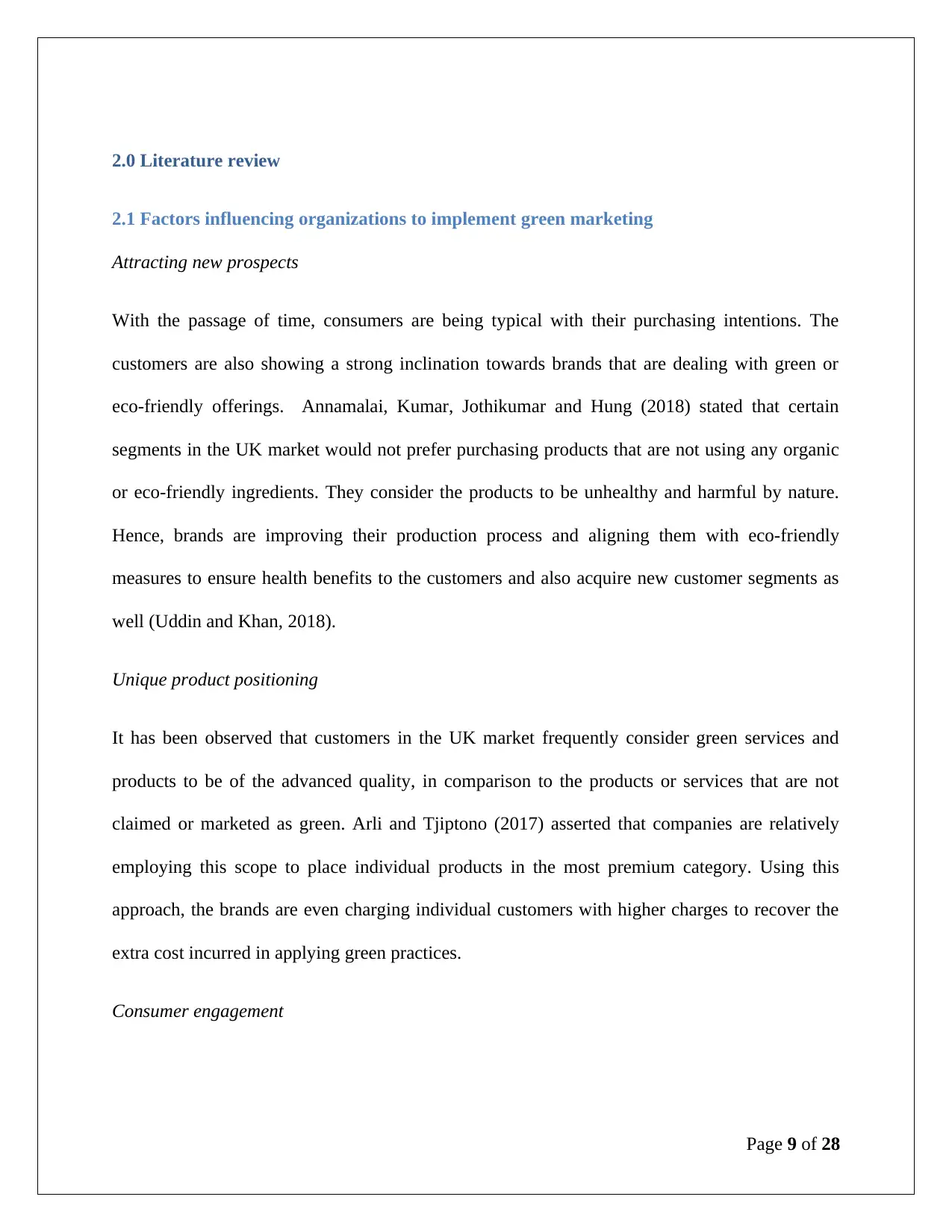
2.0 Literature review
2.1 Factors influencing organizations to implement green marketing
Attracting new prospects
With the passage of time, consumers are being typical with their purchasing intentions. The
customers are also showing a strong inclination towards brands that are dealing with green or
eco-friendly offerings. Annamalai, Kumar, Jothikumar and Hung (2018) stated that certain
segments in the UK market would not prefer purchasing products that are not using any organic
or eco-friendly ingredients. They consider the products to be unhealthy and harmful by nature.
Hence, brands are improving their production process and aligning them with eco-friendly
measures to ensure health benefits to the customers and also acquire new customer segments as
well (Uddin and Khan, 2018).
Unique product positioning
It has been observed that customers in the UK market frequently consider green services and
products to be of the advanced quality, in comparison to the products or services that are not
claimed or marketed as green. Arli and Tjiptono (2017) asserted that companies are relatively
employing this scope to place individual products in the most premium category. Using this
approach, the brands are even charging individual customers with higher charges to recover the
extra cost incurred in applying green practices.
Consumer engagement
Page 9 of 28
2.1 Factors influencing organizations to implement green marketing
Attracting new prospects
With the passage of time, consumers are being typical with their purchasing intentions. The
customers are also showing a strong inclination towards brands that are dealing with green or
eco-friendly offerings. Annamalai, Kumar, Jothikumar and Hung (2018) stated that certain
segments in the UK market would not prefer purchasing products that are not using any organic
or eco-friendly ingredients. They consider the products to be unhealthy and harmful by nature.
Hence, brands are improving their production process and aligning them with eco-friendly
measures to ensure health benefits to the customers and also acquire new customer segments as
well (Uddin and Khan, 2018).
Unique product positioning
It has been observed that customers in the UK market frequently consider green services and
products to be of the advanced quality, in comparison to the products or services that are not
claimed or marketed as green. Arli and Tjiptono (2017) asserted that companies are relatively
employing this scope to place individual products in the most premium category. Using this
approach, the brands are even charging individual customers with higher charges to recover the
extra cost incurred in applying green practices.
Consumer engagement
Page 9 of 28
⊘ This is a preview!⊘
Do you want full access?
Subscribe today to unlock all pages.

Trusted by 1+ million students worldwide
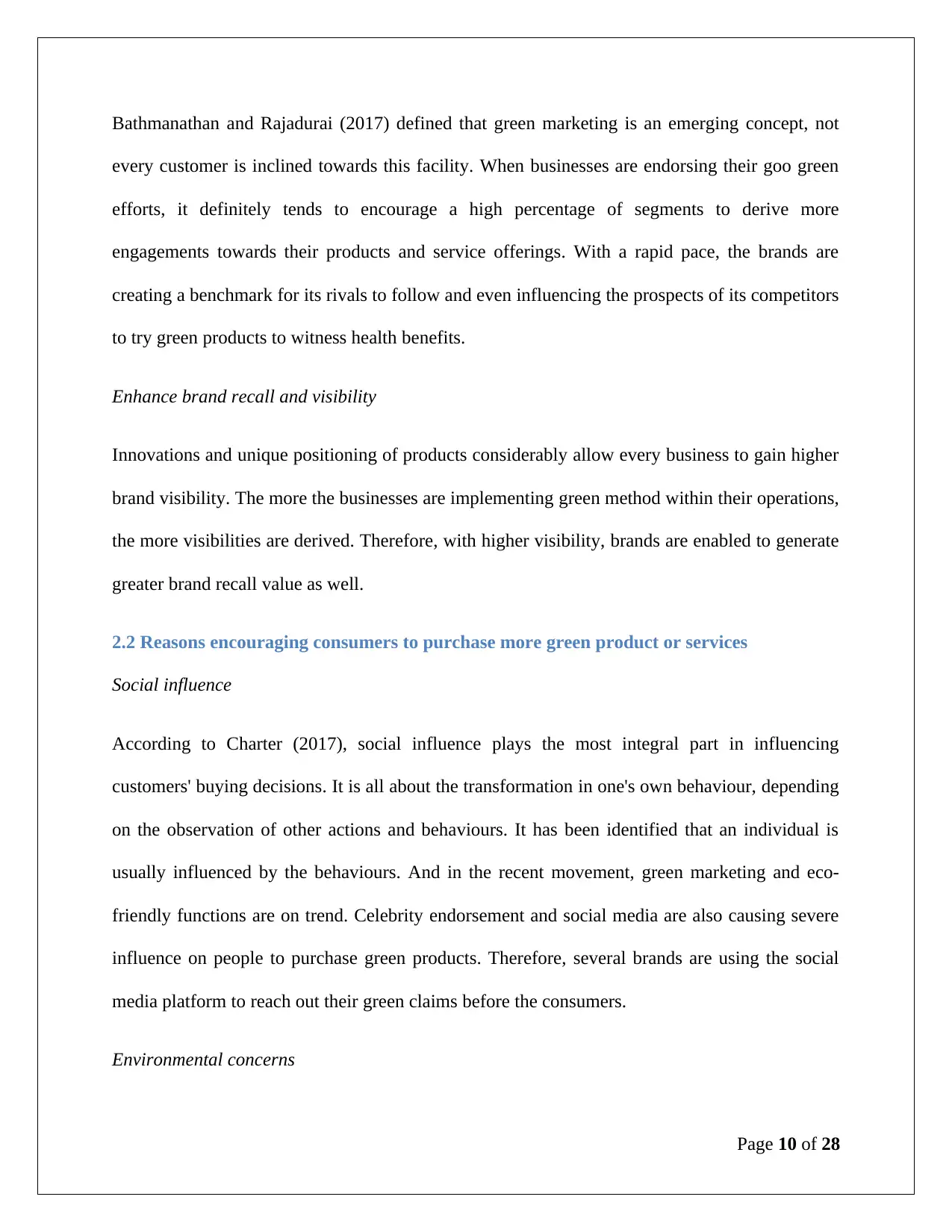
Bathmanathan and Rajadurai (2017) defined that green marketing is an emerging concept, not
every customer is inclined towards this facility. When businesses are endorsing their goo green
efforts, it definitely tends to encourage a high percentage of segments to derive more
engagements towards their products and service offerings. With a rapid pace, the brands are
creating a benchmark for its rivals to follow and even influencing the prospects of its competitors
to try green products to witness health benefits.
Enhance brand recall and visibility
Innovations and unique positioning of products considerably allow every business to gain higher
brand visibility. The more the businesses are implementing green method within their operations,
the more visibilities are derived. Therefore, with higher visibility, brands are enabled to generate
greater brand recall value as well.
2.2 Reasons encouraging consumers to purchase more green product or services
Social influence
According to Charter (2017), social influence plays the most integral part in influencing
customers' buying decisions. It is all about the transformation in one's own behaviour, depending
on the observation of other actions and behaviours. It has been identified that an individual is
usually influenced by the behaviours. And in the recent movement, green marketing and eco-
friendly functions are on trend. Celebrity endorsement and social media are also causing severe
influence on people to purchase green products. Therefore, several brands are using the social
media platform to reach out their green claims before the consumers.
Environmental concerns
Page 10 of 28
every customer is inclined towards this facility. When businesses are endorsing their goo green
efforts, it definitely tends to encourage a high percentage of segments to derive more
engagements towards their products and service offerings. With a rapid pace, the brands are
creating a benchmark for its rivals to follow and even influencing the prospects of its competitors
to try green products to witness health benefits.
Enhance brand recall and visibility
Innovations and unique positioning of products considerably allow every business to gain higher
brand visibility. The more the businesses are implementing green method within their operations,
the more visibilities are derived. Therefore, with higher visibility, brands are enabled to generate
greater brand recall value as well.
2.2 Reasons encouraging consumers to purchase more green product or services
Social influence
According to Charter (2017), social influence plays the most integral part in influencing
customers' buying decisions. It is all about the transformation in one's own behaviour, depending
on the observation of other actions and behaviours. It has been identified that an individual is
usually influenced by the behaviours. And in the recent movement, green marketing and eco-
friendly functions are on trend. Celebrity endorsement and social media are also causing severe
influence on people to purchase green products. Therefore, several brands are using the social
media platform to reach out their green claims before the consumers.
Environmental concerns
Page 10 of 28
Paraphrase This Document
Need a fresh take? Get an instant paraphrase of this document with our AI Paraphraser
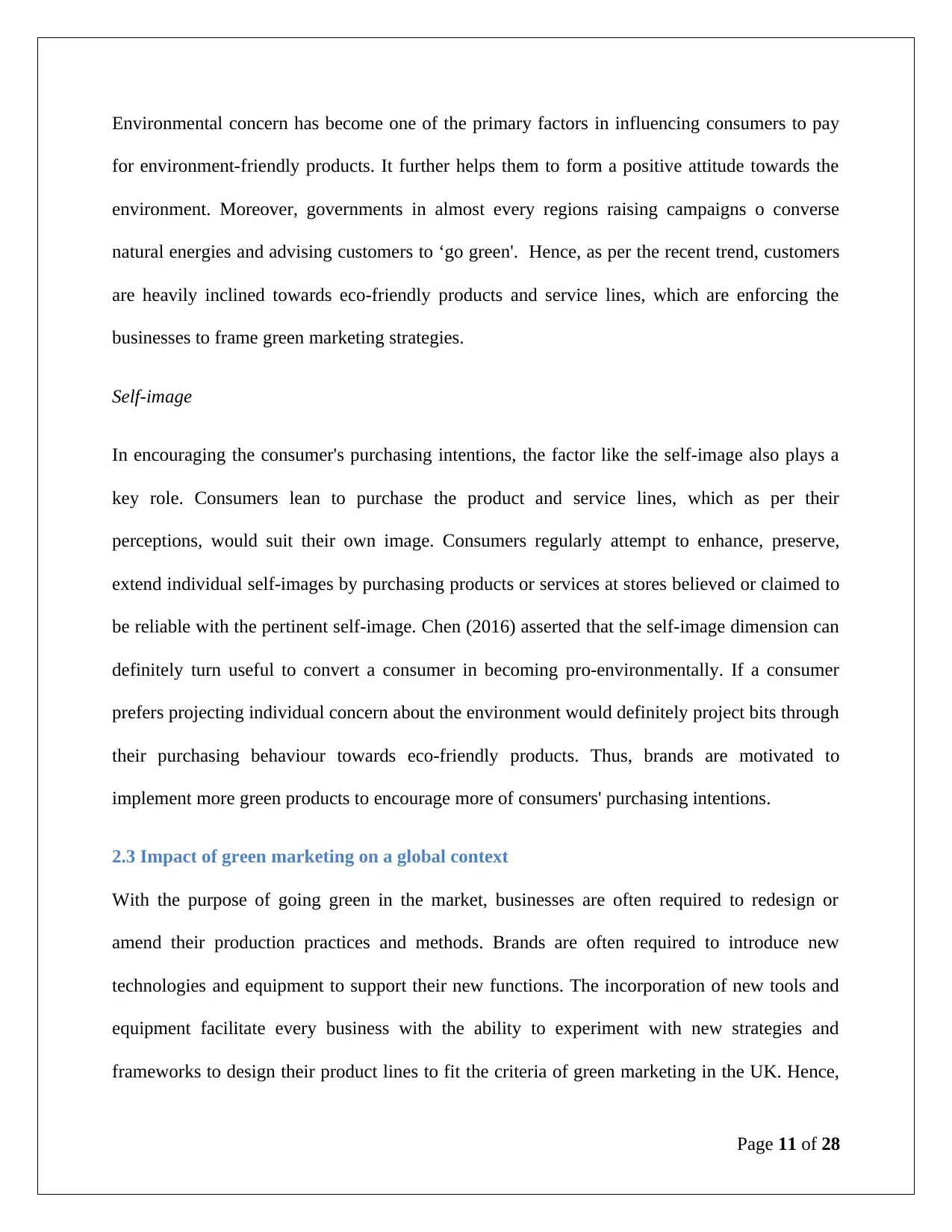
Environmental concern has become one of the primary factors in influencing consumers to pay
for environment-friendly products. It further helps them to form a positive attitude towards the
environment. Moreover, governments in almost every regions raising campaigns o converse
natural energies and advising customers to ‘go green'. Hence, as per the recent trend, customers
are heavily inclined towards eco-friendly products and service lines, which are enforcing the
businesses to frame green marketing strategies.
Self-image
In encouraging the consumer's purchasing intentions, the factor like the self-image also plays a
key role. Consumers lean to purchase the product and service lines, which as per their
perceptions, would suit their own image. Consumers regularly attempt to enhance, preserve,
extend individual self-images by purchasing products or services at stores believed or claimed to
be reliable with the pertinent self-image. Chen (2016) asserted that the self-image dimension can
definitely turn useful to convert a consumer in becoming pro-environmentally. If a consumer
prefers projecting individual concern about the environment would definitely project bits through
their purchasing behaviour towards eco-friendly products. Thus, brands are motivated to
implement more green products to encourage more of consumers' purchasing intentions.
2.3 Impact of green marketing on a global context
With the purpose of going green in the market, businesses are often required to redesign or
amend their production practices and methods. Brands are often required to introduce new
technologies and equipment to support their new functions. The incorporation of new tools and
equipment facilitate every business with the ability to experiment with new strategies and
frameworks to design their product lines to fit the criteria of green marketing in the UK. Hence,
Page 11 of 28
for environment-friendly products. It further helps them to form a positive attitude towards the
environment. Moreover, governments in almost every regions raising campaigns o converse
natural energies and advising customers to ‘go green'. Hence, as per the recent trend, customers
are heavily inclined towards eco-friendly products and service lines, which are enforcing the
businesses to frame green marketing strategies.
Self-image
In encouraging the consumer's purchasing intentions, the factor like the self-image also plays a
key role. Consumers lean to purchase the product and service lines, which as per their
perceptions, would suit their own image. Consumers regularly attempt to enhance, preserve,
extend individual self-images by purchasing products or services at stores believed or claimed to
be reliable with the pertinent self-image. Chen (2016) asserted that the self-image dimension can
definitely turn useful to convert a consumer in becoming pro-environmentally. If a consumer
prefers projecting individual concern about the environment would definitely project bits through
their purchasing behaviour towards eco-friendly products. Thus, brands are motivated to
implement more green products to encourage more of consumers' purchasing intentions.
2.3 Impact of green marketing on a global context
With the purpose of going green in the market, businesses are often required to redesign or
amend their production practices and methods. Brands are often required to introduce new
technologies and equipment to support their new functions. The incorporation of new tools and
equipment facilitate every business with the ability to experiment with new strategies and
frameworks to design their product lines to fit the criteria of green marketing in the UK. Hence,
Page 11 of 28
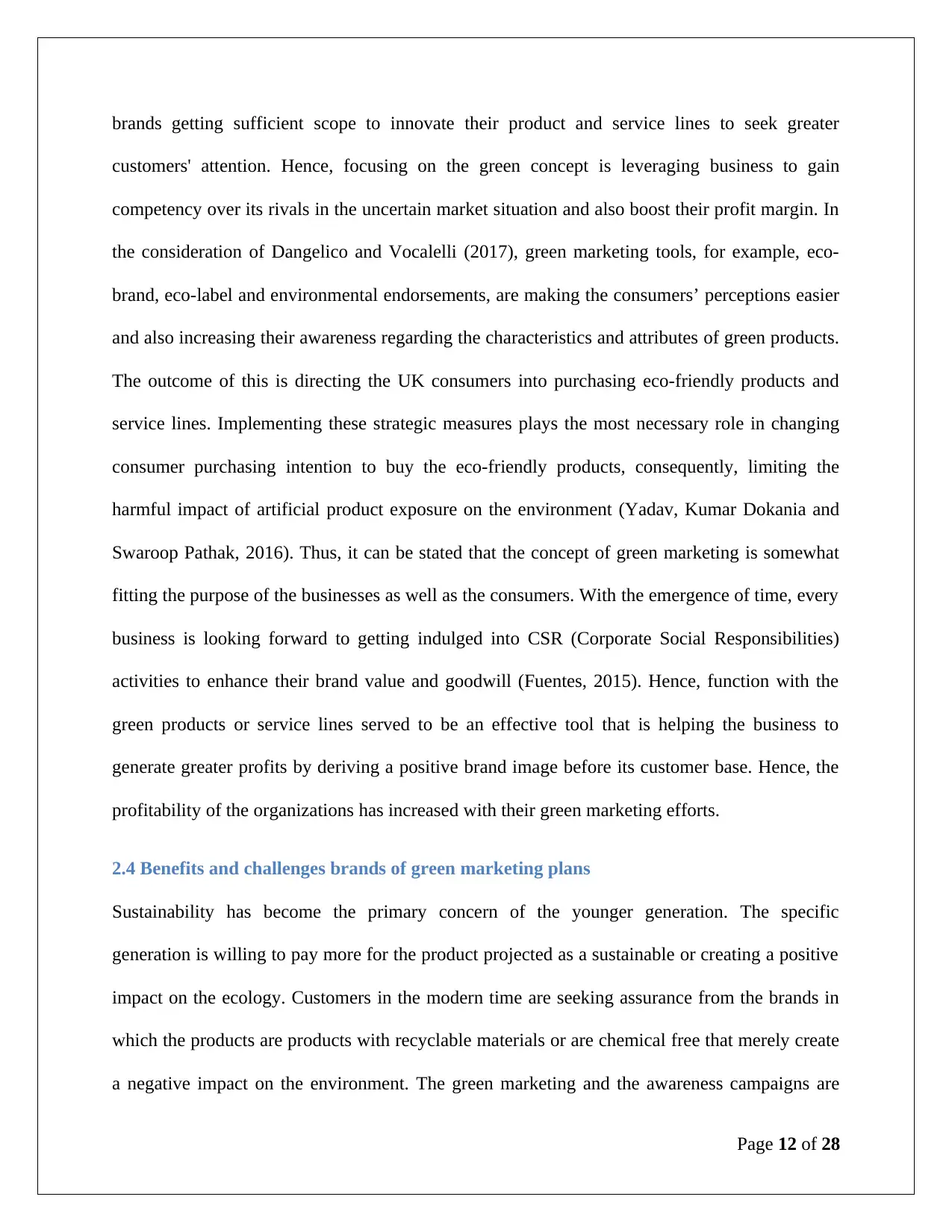
brands getting sufficient scope to innovate their product and service lines to seek greater
customers' attention. Hence, focusing on the green concept is leveraging business to gain
competency over its rivals in the uncertain market situation and also boost their profit margin. In
the consideration of Dangelico and Vocalelli (2017), green marketing tools, for example, eco-
brand, eco-label and environmental endorsements, are making the consumers’ perceptions easier
and also increasing their awareness regarding the characteristics and attributes of green products.
The outcome of this is directing the UK consumers into purchasing eco-friendly products and
service lines. Implementing these strategic measures plays the most necessary role in changing
consumer purchasing intention to buy the eco-friendly products, consequently, limiting the
harmful impact of artificial product exposure on the environment (Yadav, Kumar Dokania and
Swaroop Pathak, 2016). Thus, it can be stated that the concept of green marketing is somewhat
fitting the purpose of the businesses as well as the consumers. With the emergence of time, every
business is looking forward to getting indulged into CSR (Corporate Social Responsibilities)
activities to enhance their brand value and goodwill (Fuentes, 2015). Hence, function with the
green products or service lines served to be an effective tool that is helping the business to
generate greater profits by deriving a positive brand image before its customer base. Hence, the
profitability of the organizations has increased with their green marketing efforts.
2.4 Benefits and challenges brands of green marketing plans
Sustainability has become the primary concern of the younger generation. The specific
generation is willing to pay more for the product projected as a sustainable or creating a positive
impact on the ecology. Customers in the modern time are seeking assurance from the brands in
which the products are products with recyclable materials or are chemical free that merely create
a negative impact on the environment. The green marketing and the awareness campaigns are
Page 12 of 28
customers' attention. Hence, focusing on the green concept is leveraging business to gain
competency over its rivals in the uncertain market situation and also boost their profit margin. In
the consideration of Dangelico and Vocalelli (2017), green marketing tools, for example, eco-
brand, eco-label and environmental endorsements, are making the consumers’ perceptions easier
and also increasing their awareness regarding the characteristics and attributes of green products.
The outcome of this is directing the UK consumers into purchasing eco-friendly products and
service lines. Implementing these strategic measures plays the most necessary role in changing
consumer purchasing intention to buy the eco-friendly products, consequently, limiting the
harmful impact of artificial product exposure on the environment (Yadav, Kumar Dokania and
Swaroop Pathak, 2016). Thus, it can be stated that the concept of green marketing is somewhat
fitting the purpose of the businesses as well as the consumers. With the emergence of time, every
business is looking forward to getting indulged into CSR (Corporate Social Responsibilities)
activities to enhance their brand value and goodwill (Fuentes, 2015). Hence, function with the
green products or service lines served to be an effective tool that is helping the business to
generate greater profits by deriving a positive brand image before its customer base. Hence, the
profitability of the organizations has increased with their green marketing efforts.
2.4 Benefits and challenges brands of green marketing plans
Sustainability has become the primary concern of the younger generation. The specific
generation is willing to pay more for the product projected as a sustainable or creating a positive
impact on the ecology. Customers in the modern time are seeking assurance from the brands in
which the products are products with recyclable materials or are chemical free that merely create
a negative impact on the environment. The green marketing and the awareness campaigns are
Page 12 of 28
⊘ This is a preview!⊘
Do you want full access?
Subscribe today to unlock all pages.

Trusted by 1+ million students worldwide
1 out of 28
Related Documents
Your All-in-One AI-Powered Toolkit for Academic Success.
+13062052269
info@desklib.com
Available 24*7 on WhatsApp / Email
![[object Object]](/_next/static/media/star-bottom.7253800d.svg)
Unlock your academic potential
Copyright © 2020–2025 A2Z Services. All Rights Reserved. Developed and managed by ZUCOL.




